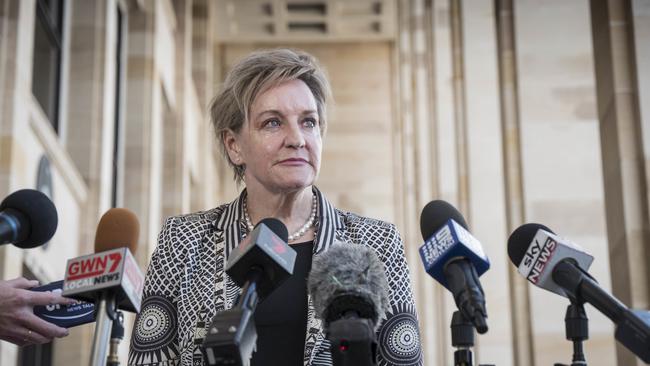Women in agriculture: Barriers remain for female farming leaders
On International Day of Rural Women, a young farming leader reveals the gains women have made in the ag industry, and the barriers they still face.
At just 27 years of age, South Australia’s Monica Ley has spent the past decade working in agriculture.
And she wouldn’t have it any other way.
Since finishing school in Victoria’s Kiewa Valley, Monica is now livestock manager at Canowie Poll Merino in South Australia. She was recently appointed to the Australian Wool Growers Association board: one of the first women to be elected in the board’s 24-year history.
But before a legal decision was made the same year Monica was born, there was legally no such thing as a female farmer in Australia.
It wasn’t until 1994 when the Australian Law Reform Commission redefined women’s legal status and granted females in Australia the title of “farmer”. Before then, women were simply called domestics; farmer’s wives; or helpers.
This isn’t to say women weren’t working on farms and in agriculture before the 1990s: their history is well documented. But legal acknowledgment of their presence within the industry is more important than ever.
Monica knows the sensation of feeling invisible more than anyone, and despite her new position of authority, there are often times when her presence isn’t even acknowledged.
“I have been to workshops, producer workshops, where I am maybe one of two female producers in the room … and without a doubt, it’s “welcome gentlemen” every time,” she says.
“It’s tiring. I’m sitting in the front, but I’m still not noticed.”
And when she is noticed, it’s not always in a positive light.
Since news broke of her role on the AWGA board, she says her inbox was flooded with commentary from the public, calling her appointment a “token gesture”.
“I think people are scared of change,” she says.
“The wool industry is an industry which has been in this country since the 1800s. It’s still quite traditional, and that could be why the pushback is there. It’s something different: something they may not have seen before.”

CENSUS figures show the industry is showing signs of progression when it comes to women’s participation in the industry. The 2018 Snapshot of Australia’s Agricultural Workforce report shows the number of women working in agriculture has lifted in the past 10 years: in 2016, the number of women employed in agriculture accounted for 32 per cent of the total agricultural workforce.
Yet a gap remains between the women toiling in sale yards, at market gardens, and in the paddocks compared to those making industry-wide decisions.
A report published by Meat Business Women in 2020 showed women accounted for 36 per cent of surveyed meat industry business employees. But of those surveyed women, just 14 per cent held board-level director roles within the meat industry, and a mere 5 per cent chief executive roles.
Agriculture is a dynamic, innovative industry; perfect for smart, educated women seeking a challenge. And there’s no shortage of women interested in working in agriculture.
That’s according to Western Australia Agriculture Minister Alannah MacTiernan.
“Women have obviously always been important. There’s certainly now a lot of confident, educated women taking on roles in farming, and women are much more involved,” Ms MacTiernan says.
“There are the challenges, the opportunities, the technology and the environment. There’s an intellectual excitement there.
“You’re always learning, there’s a real sense of excitement.”

Ms MacTiernan spent about nine years away from politics, before returning to the role of Agriculture Minister in 2017.
She was shocked – pleasantly so – when she returned and found a boost in the number of women sitting at the boardroom table at farm group meetings.
“It was very obvious, having been away, that there had been a change,” Ms MacTiernan says.
“I got the sense the men didn’t need to be badgered into it. They really valued it.”
But when it came to the number of women participating at a decision-making level, she was frustrated time and time again with the absence of women stepping into positions of authority within the industry.
Sifting through submissions for industry funding schemes, she noted the stark lack of applications from women.
She turned her mind to the number of women she knew who worked across the agricultural sector; to the faces looking back at her from the crowd at those farm group meetings.
Where were their applications?
“There’s no shortage of smart women, how come all of the applications I’m getting are from men?” MacTiernan says.
As Ms MacTiernan discovered, when it comes to women participating in agriculture at a senior, executive-level the numbers being to peter out.
Yet when more women are appointed to positions of authority in agriculture, the entire business benefits. The Meat Business Women report shows companies with executive committees with female representation greater than 33 per cent “have a net profit margin over 10 times great” than companies with no women at an executive level.
In an op-ed penned by ANZ associate director agribusiness research Bryony Callander, despite the successes of women in agriculture, a gender wage gap still remains.
“According to the Australian Bureau of Statistics, women in agriculture, forestry and fishing earn 22 per cent less than their male counterparts,” Ms Callander says.
Women also own less property than men Australia-wide.
“This figure is marginally higher in regional areas,” Ms Callander says.
“Logically this makes land ownership even more difficult for women in agriculture.”
WHILE gender stereotypes may have once restricted on-farm experiences for girls, Ms Callander says it’s now more common for children to be raised equally on farms.
“When young women are given the opportunity to be involved and to develop the hands-on skills required, this builds their confidence to continue working to develop into farmers of the future,” Ms Callander says.
Raising children equally is one element of fostering the next generation of primary producers.
But for Monica Ley, representation is vital for the young women and girls of Australia looking to the future.
“Representation matters, in the media, in the board room, wherever,” Ley says.
“If you can’t see it’s possible for someone who looks like you, who shares your unique set of experiences, you’ll be discouraged.”





